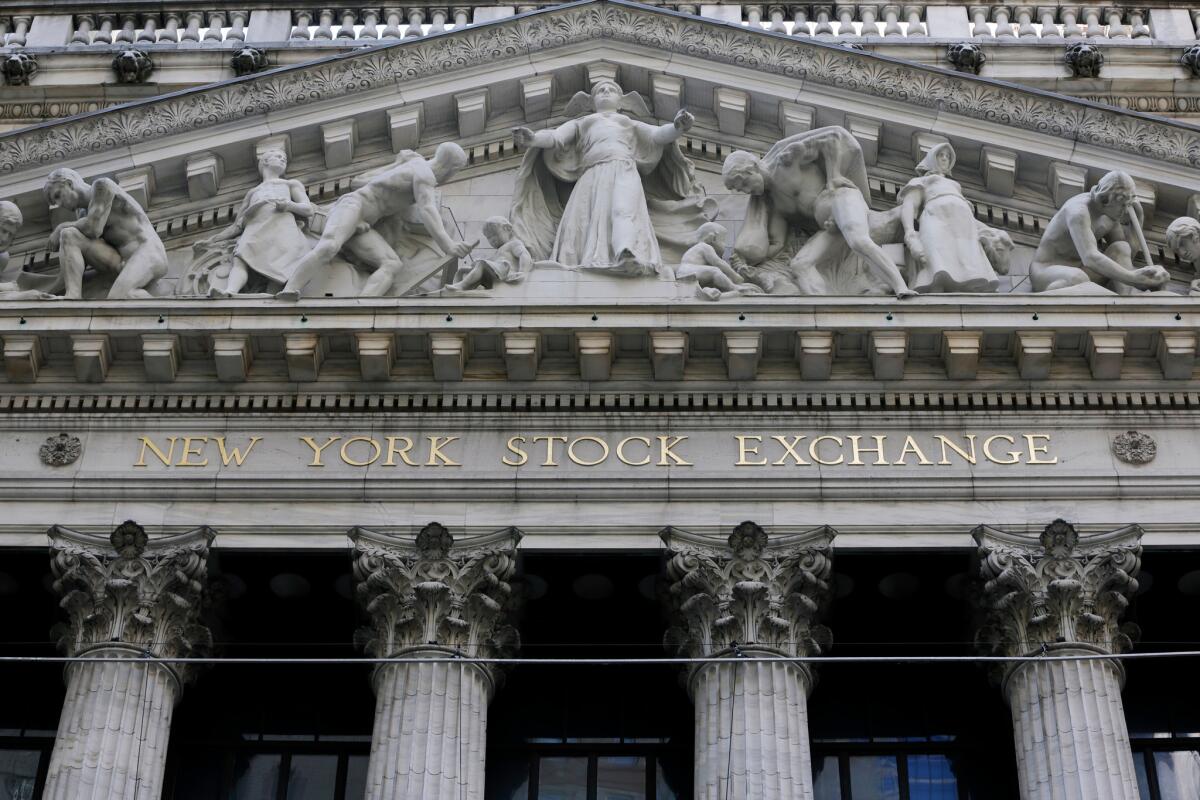Stocks slide after Fed interest-rate cut fails to cure investors’ dread

- Share via
Fear and uncertainty continued to control Wall Street, with U.S. stocks falling sharply Tuesday after an emergency interest-rate cut by the Federal Reserve failed to reassure markets wracked by worries that the fast-spreading coronavirus outbreak will cause a recession.
The Dow Jones industrial average sank 785.91 points, or 2.9%. It had surged 5% on Monday as investors hoped for a broader set of stimulus measures.
Although the cut gave some investors exactly what they had been asking for, Federal Reserve Chairman Jerome Powell acknowledged that the solution to the virus outbreak must come from health experts and the like, not from central banks. Some traders wonder whether more aid is on the way to stabilize the market, while others called the Fed’s move premature to begin with. For more than a few, the Fed’s steepest rate cut since 2008 recalled the dark days of the financial crisis and only added to the dread.
Through it all, markets still face the quandary that has sent stock prices tumbling 11% since their record highs of just two weeks ago: No one knows how far the virus will spread before authorities can get it under control, and how much the outbreak will harm companies’ profits.
That uncertainty led to jagged trading across markets Tuesday. Stocks rallied briefly in the morning after the Fed’s surprise move, but it took just 15 minutes for the gains to evaporate. The yield on the 10-year Treasury fell below 1% for the first time in history as investors ratcheted back expectations for the economy and inflation. The VIX “fear index,” which measures traders’ expectations of upcoming volatility in the stock market, jerked wildly up and down through the day.
After popping to a 1.5% gain shortly after the Fed’s announcement, the Standard & Poor’s 500 index wavered between modest gains and losses for about an hour before turning decisively lower. The index ended the day down 86.86 points, or 2.8%, at 3,003.37 — its eighth drop in the last nine trading days. The Nasdaq composite fell 268.07, or 3%, to 8,684.09.
Bond yields swung after the Fed’s announcement. The yield on the 10-year Treasury slumped to 1.01% from 1.08%, and during the day it touched below the 1% threshold for the first time. The 10-year yield tends to fall when expectations are for weak economic growth and inflation. Shorter-term yields, which move more on Fed actions, had even more dramatic drops. The two-year Treasury yield sank to 0.71% from 0.81%.
The Fed has a long history of coming to the market’s rescue by lowering interest rates and introducing other stimulus, which has helped this bull market in U.S. stocks become the longest on record. Some analysts said the Fed’s latest cut could provide some more confidence; others said it may have spooked investors by causing them to wonder if the Fed saw things as worse than they were led to believe.
Markets are likely to remain shaky until investors get a sense of what the worst-case scenario really is in this virus outbreak. They have been on edge for nearly two weeks, as the virus spreads beyond China and companies across continents and industries say they expect it to hit their profits.
On Tuesday, payments processor Visa joined the list of companies warning investors about coronavirus effects. It said its quarterly revenue will be weaker than it had predicted because of a drop in travel-related spending on cards.
“To get a floor on the markets, realistically, what we need to see is not so much a cut in the number of new coronavirus cases, but at least a slowdown in the acceleration,” said Salvatore Bruno, chief investment officer for IndexIQ. “Up until that time, we’re likely to see a lot of volatility.”
Worldwide, more than 92,000 people have been sickened and over 3,100 have died in the coronavirus outbreak. The number of countries hit by the virus has reached at least 70, with Ukraine and Morocco reporting their first cases.
Tuesday’s trading got off to a slow start in the United States. Earlier in the day, the Group of 7 major industrialized countries pledged support for the global economy, but they stopped short of announcing any specific new measures. Disappointment in the lack of action helped push U.S. stocks lower at the opening of trading, before the Fed surprised markets by announcing the interest-rate cut.
Investors are still speculating about whether other central banks will join and cut rates and offer stimulus in a coordinated effort around the world. Before the Fed made its move, the Reserve Bank of Australia cut its key interest rate to a record low 0.5%.
European stock markets were broadly higher. Asian markets were also generally strong, though Japan’s Nikkei 225 fell 1.2%.
More to Read
Inside the business of entertainment
The Wide Shot brings you news, analysis and insights on everything from streaming wars to production — and what it all means for the future.
You may occasionally receive promotional content from the Los Angeles Times.










